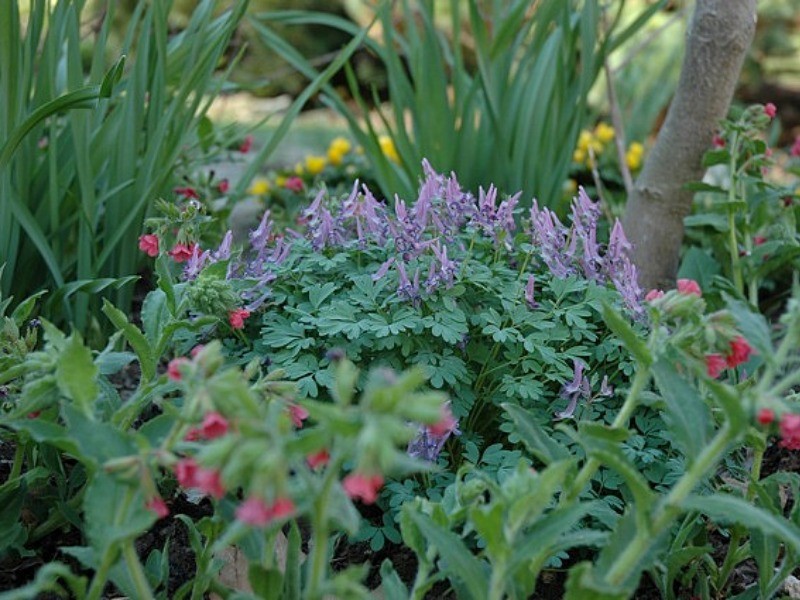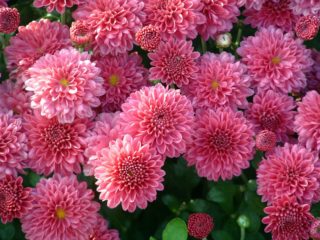Content
Corydalis solida or Hallera (corydalis solida) is a perennial herbaceous plant with a short growing season in early spring. The culture is a representative of the Poppy family and is distinguished by its compactness and grace. Thanks to its unpretentiousness, Haller's corydalis has become widespread as an element of landscape design. In order for the plant to develop properly and enjoy lush flowering every year, it is necessary to provide it with favorable conditions taking into account the requirements of the culture.
Description of dense corydalis
This perennial belongs to the category of low-growing crops. It reaches its maximum height during flowering, it varies between 10-20 cm. The stems are erect, simple or may have one lateral shoot, which is formed in the axil of the leaf.
The root system of the plant is represented by a light brown tuber, the diameter of which is 8-15 mm. In the lower part of the shoots, the dense corydalis species has recovery buds. A cambium is formed at their base, stimulating the development of young replacement tubers.
The leaves are compound, double- or triple-pinnate, consisting of separate segments having a triangular or rounded shape, each of them with a separate petiole. No more than two plates are formed on the stem of the dense corydalis species. The inflorescences of the plant are apical, racemose, in the form of an elongated cylinder. They consist of 5-35 small elongated buds, the corolla length of which is 1.5-2.5 cm. The petals are bent in front. All Haller's corydalis flowers have long spurs that contain nectar. Only insects with a long proboscis can get it. The color of the flowers of the dense corydalis can be red, pink, lilac, violet, white and yellow.
After pollination, fruits appear on the plant in the form of oblong boxes, inside of which small glossy black seeds with a diameter of about 2 mm are formed. Each of them has a fleshy growth that attracts ants. Therefore, these insects carry corydalis seeds over long distances and thus contribute to the spread of the culture.
The perennial begins its growing season in March, and already in mid-April its first buds bloom. The flowering period lasts for three weeks. Haller's corydalis seeds ripen in June. After this, the above-ground part of the plant completely dies.

The plant blooms for the first time at the age of 4-6 years
Is the corydalis poisonous?
The perennial belongs to the category of poisonous plants, as it contains alkaloids. Therefore, you need to wear gloves when working with the plant. However, despite this, the culture is considered medicinal.Therefore, it can be used for medicinal purposes, taking into account existing contraindications.
Medicinal properties of Corydalis dense
This plant has found wide use in folk medicine because it has analgesic, hemostatic, astringent, anti-inflammatory, hypnotic, antioxidant and anesthetic effects. In addition, the culture exhibits antitumor activity.
The medicinal properties of the dense corydalis species are used to treat:
- impotence;
- diseases of the digestive tract;
- insomnia;
- cancer;
- hypertension;
- hysteria.
Application of dense corydalis
Haller's corydalis can be used for medicinal purposes only in small quantities, since it contains substances that have a strong effect on the human body. Exceeding the dosage causes inhibition of reflex activity, voluntary movements and can cause catalepsy.
This perennial is used for landscaping. After all, it begins to bloom when most garden crops are just awakening after winter. The coridalis plant looks good in mono-plantings, and thanks to its compact size, it can be used as a ground cover to disguise unsightly places in early spring.
Where does dense corydalis grow?
Haller's Corydalis grows in temperate regions of the Northern Hemisphere. The culture is widespread in European countries, Western Siberia, and is also found in Asia Minor and Central Asia. Prefers sunny areas, easily tolerates a lack of moisture, but suffers from its excess in the soil.
Landing rules
You can plant dense corydalis when the plant's bulbs are dormant, that is, from June to September. Dense, juicy tubers without signs of rot are suitable for planting. The culture prefers areas where moisture does not stagnate even during thaws and prolonged rains. The soil needs to be dug up and fine gravel and sand added to it, 5-10 kg per square meter. m, depending on the composition of the soil.
Haller's Corydalis bulbs with a diameter of up to 10 mm are recommended to be planted to a depth of 5-7 cm, and over 11 mm - to a depth of 10 cm. At the end of the procedure, it is recommended to water them well.

When planting, a distance of 10-15 cm must be maintained between the bulbs.
Care instructions
The dense corydalis plant (corydalis solida) belongs to the category of unpretentious crops that do not particularly require the gardener’s attention. The perennial growing season begins in early spring, so there is no need to water it during this period. Moistening of the dense corydalis is required only during flowering and after it, if the need arises. After watering, it is recommended to loosen the soil at the base of the plant to maintain air access to the bulbs.
It is necessary to feed the corydalis with humus. To do this, in early spring, it is necessary to lay a layer of organic matter up to 3 cm thick near the plant. If it is not available, you can use nitroammophoska at the rate of 30 g per 1 sq. m. m, scattering fertilizer granules near the dense corydalis and then embedding them into the soil. The plant does not need shelter for the winter.
Reproduction methods
This perennial can be propagated by seeds and tubers.In the first case, it is necessary to collect planting material on time, about a week after the start of flowering. At this time, the capsule fruits are still green, but the seeds inside them are already turning black. If you skip this moment, they may simply spill out onto the ground after opening the pod.
It is recommended to initially plant seeds in a container at home. And only after a year transfer the seedlings to open ground. Seeds of the dense corydalis sprout 2-3 weeks after planting. Their germination level is 70-80%.

Plants grown from seeds bloom in the third year
During the growth process, the perennial produces daughter bulbs, which can also be used for its propagation. It is recommended to separate them between June and September. After this, it is recommended to plant them in a permanent place. In this case, young seedlings bloom in the second year.
Photos in landscape design
Haller's corydalis is increasingly popular as an element of landscape design. It can be used in single and group plantings, creating unusual compositions.

Corydalis dense goes well with other primroses

Perennial fills empty spaces in a flower bed well

The plant can also be planted at the base of trees.

The perennial also looks original when planted in groups of different varieties.
Conclusion
Corydalis dense is a plant that can delight with early flowering. In addition, it does not require complex care, so it will not cause much trouble for the gardener. It is enough to only water it occasionally, if there is little rain in the spring, and feed it occasionally.The advantage of the perennial is that it can be planted at the base of deciduous shrubs and trees, since during its growing season they do not create shade for it.
Reviews of dense corydalis









